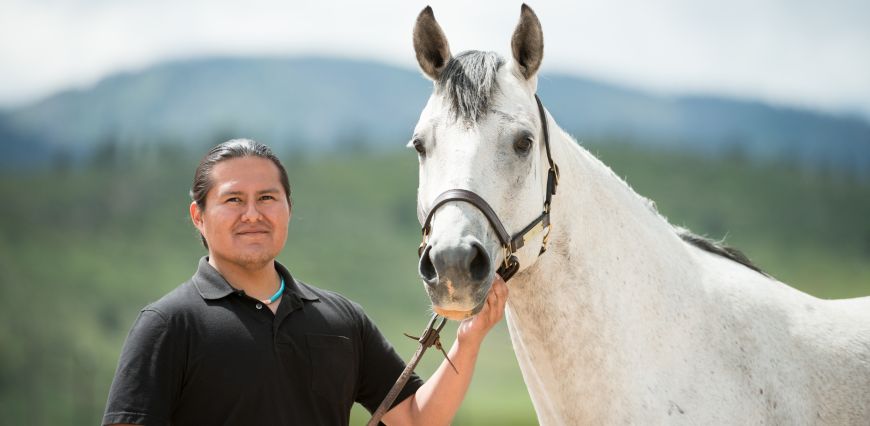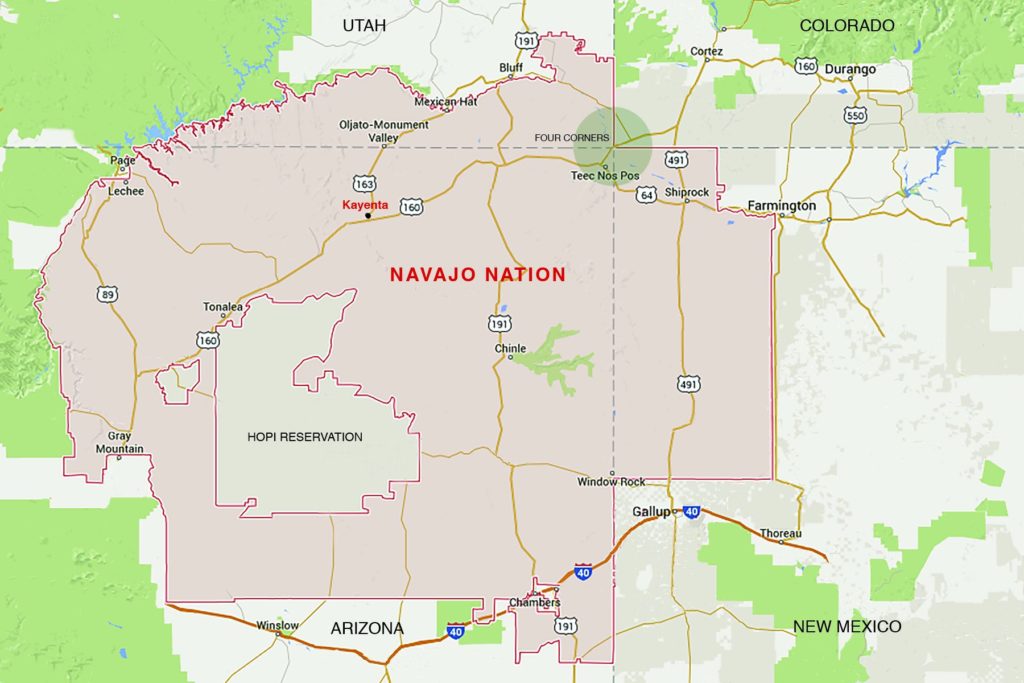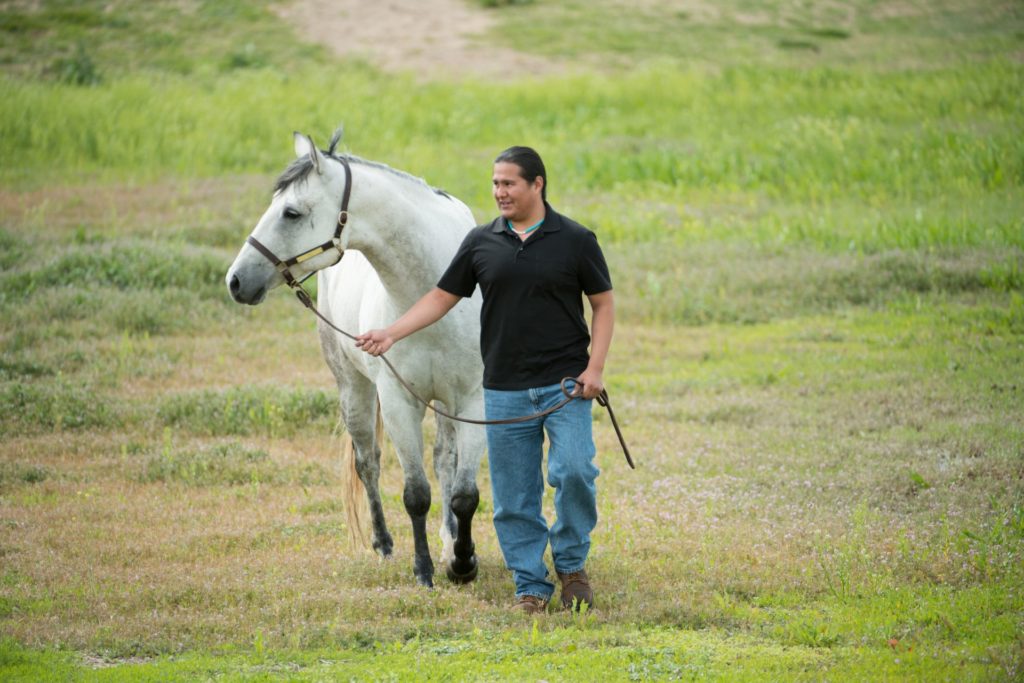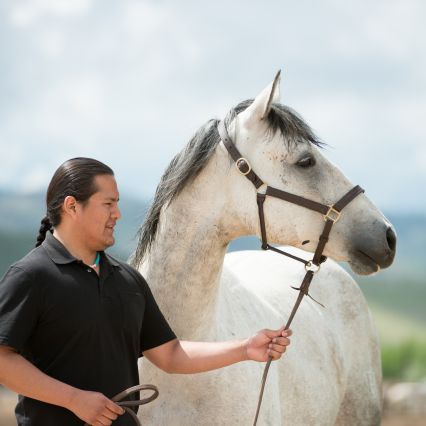
Veterinary student Patrick Succo is teaching high-schoolers in the Navajo Nation about equine health; he helped spark a new partnership involving the Colorado State veterinary program. Photo by John Eisele/Colorado State University
Colorado State University veterinary students recently provided essential animal-care instruction for high-schoolers in the Navajo Nation, equipping teenagers with basic veterinary skills in a region dependent on livestock production – while also encouraging the teens to pursue college education.
The project was prompted by Navajo veterinary student Patrick Succo, 26, who grew up in Ts’ah bii Kin, or “House in the Sagebrush,” and was inspired a decade ago to pursue veterinary medicine in a program very much like the one he led in early June – and in the very same place.
“Veterinary medicine is what I really want to do, and that’s where it all started,” said Succo, entering his second year in Colorado State’s DVM Program. “I’m hoping the high-school students who attended our workshops will gain the motivation to pursue higher education like I did.”
Camp based at center in Kayenta
The veterinary outreach project was at the nationally acclaimed Agri-Science Center at Monument Valley High School in Kayenta, Ariz. Sixty high-school students attended the veterinary summer camp June 6-10, and CSU veterinary students hope their participation will lead to future outreach efforts based at the center.
Succo, along with CSU veterinary students Jake Rodgers and Megan Kelley, provided camp sessions about pet, equine and livestock vaccinations, parasitology, infectious disease, physical exams, wound care, surgical preparation and dental care. Some sessions focused on cattle, sheep and horses, which are central to agricultural life and livelihoods in Navajo country.
“I think we made a huge impact on the kids, their community, and the health of the animals in Kayenta,” Succo said when the camp concluded. “Kayenta community members are looking forward to more partnerships with our CSU veterinary school, and they would love to have us back next time. Other schools and animal-related programs on the Navajo Nation have been contacting me about potentially sending veterinary students to their schools as guest speakers to talk about the veterinary profession. I think we made a great first impression.”
Leaders of the CSU Doctor of Veterinary Medicine Program are now considering how the program might partner with the Agri-Science Center at Monument Valley High School on other outreach efforts that could benefit high-schoolers, livestock producers, pet owners and a plethora of animals in Navajo country – while also boosting medical skills and cultural competency among Colorado State veterinary students.

Camp could lead to more outreach
“When Patrick told me about this opportunity, it seemed like a natural alliance. It was exciting to visit Kayenta and imagine how this first camp collaboration could grow,” said Dr. Melinda Frye, a veterinarian and CSU associate dean for veterinary academic and student affairs.

The Agri-Science Center, completed in 2011, was the brainchild of Clyde McBride, who teaches vocational agriculture and veterinary science at Monument Valley. He convinced his tiny school district in Navajo country to construct the $2.4 million, 22,000-square-foot facility to teach high-schoolers practical veterinary skills and to provide the community with a fully functional veterinary clinic, including classrooms, treatment areas, specialized livestock-handling equipment, and surgical suites for large and small animals.
McBride received the 2015 National Teacher of the Year Award from the Association for Career and Technical Education. A story in TIME magazine, headlined “Learning That Works,” described McBride’s approach to teaching agricultural science for Navajo high-schoolers. “These kids are thirsty,” McBride says in the TIME story. “All you’ve got to do is let them drink.”
Student returns to inspirational program
Succo was one of his students. His interest in veterinary medicine sparked when Succo was 16 years old and a member of the Monument Valley FFA chapter under McBride’s tutelage. Succo had grown up raising horses, cattle, sheep and hay with his family; the career light clicked on when Mr. McBride brought in professional veterinarians for a clinic, and the teenager helped prep animals for surgery.
Now Succo has been back home, teaching Navajo high-schoolers to determine correct vaccine dosage for horses and how to file down sharp points on their molars.
“I want to get students thinking about college and pursuing a career in something they’re passionate about,” said Succo, who studied chemistry and molecular biology at Fort Lewis College in Durango, Colo., before starting veterinary school at CSU. “It’s so great knowing that we will be bringing knowledge to the community.”
Media assets
Pictures:

Patrick Succo, a CSU veterinary student, was inspired to pursue veterinary medicine while attending Monument Valley High School in Kayenta, Ariz., where he is now helping to launch a new partnership. Photo by John Eisele/Colorado State University. (Click on photo for high-res version.)